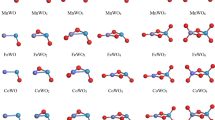Abstract
The ground-state geometrical and electronic properties of neutral and charged M n C2 (M = Fe, Co, Ni, Cu; n = 1–5) clusters are systematically investigated by density-functional calculations. The growth evolution trends of neutral and charged Fe n C2, Co n C2, Ni n C2 and Cu n C2 (n = 1–5) clusters are all from lower to higher dimensionality, while it is special for Cu n C ±2 (n = 1–5) clusters which favor planer growth model. The space directional distributions of Co and Ni indicate stronger magnetic anisotropy than that in Cu atoms. Compare with experimental data (photoelectron spectroscopy), our results are in good agreement. The interaction strengths between metal and carbon atoms in TM–C (TM = Fe, Co, Ni) clusters are comparable and are obviously larger than that in Cu–C clusters, and this interaction strengths also decrease through the sequence: cation > neutral > anion, which may be crucial in exploring the differences in the growth mechanisms of metal–carbon nano-materials.





Similar content being viewed by others
References
A. W. Castleman Jr and P. Jena (2006). PNAS. 103, 10554.
E. G. Noya, R. C. Longo, and L. J. Gallego (2003). J. Chem. Phys. 119, 11130.
A. C. Borin, J. P. Gobbo, and B. O. Roos (2006). Chem. Phys. Lett. 418, 311.
D. Tzeli and A. Mavridis (2007). J. Chem. Phys. 126, 194304.
D. J. Brugh and M. D. Morse (2002). J. Chem. Phys. 117, 10703.
G. L. Gutsev and C. W. Bauschlicher Jr (2003). Chem. Phys. 291, 27.
J. O. Joswig, M. Springborg, and G. Seifert (2001). Phys. Chem. Chem. Phys. 3, 5130.
X. Li and L. S. Wang (1999). J. Chem. Phys. 111, 8389.
K. Tono, A. Terasaki, T. Ohta, and T. Kondow (2002). J. Chem. Phys. 117, 7010.
Z. X. Zhang, B. B. Cao, and H. M. Duan (2008). J. Mol. Struct. (Theochem). 863, 22.
S. Baroni et al, http://www.quantum-espresso.org/.
O. Diéguez, M. M. G. Alemany, C. Rey, P. Ordejón, and L. J. Gallego (2001). Phys. Rev. B. 63, 205407.
M. Deshpande, D. G. Kanhere, and R. Pandey (2005). Phys. Rev. A. 71, 063202.
S. Li, M. M. G. Alemany, and J. R. Cheliknowsky (2006). J. Chem. Phys. 125, 034311.
S. Datta, M. Kabir, S. Ganguly, B. Sanyal, T. S. Dasgupta, and A. Mookerjee (2007). Phys. Rev. B. 76, 014429.
H. Purdum, P. A. Montano, G. K. Shenoy, and T. Morrison (1982). Phys. Rev. B. 25, 4412.
S. K. Loh, L. Lian, D. A. Hales, and P. B. Armentrout (1988). J. Phys. Chem. 92, 4009.
D. J. Brugh and M. D. Morse (1997). J. Chem. Phys. 107, 9772.
B. K. Nash, B. K. Rao, and P. Jena (1996). J. Chem. Phys. 105, 11020.
G. L. Gutsev and C. W. Bauschlicher (2003). J. Phys. Chem. A. 107, 4755.
A. Kant and B. Strauss (1964). J. Chem. Phys. 41, 3806.
J. C. Pinegar, J. D. Langenberg, C. A. Arrington, E. M. Spain, and M. D. Morse (1995). J. Chem. Phys. 102, 666.
M. D. Morse, G. P. Hansen, P. R. R. Langridge-Smith, L. S. Zheng, M. E. Geusic, D. L. Michalopoulos, and R. E. Smalley (1984). J. Chem. Phys. 80, 5400.
R. S. Ram, C. N. Jarman, and P. F. Bernath (1992). J. Mol. Spectrosc. 156, 468.
Z. Cao (1996). J. Mol. Struct. (Theochem). 365, 211.
A. N. Alexandrova, A. I. Boldyrev, H. J. Zhai, and L. S. Wang (2005). J. Phys. Chem. A. 109, 562.
M. L. McKee (1990). J. Am. Chem. Soc. 112, 2601.
C. W. Bauschlicher, S. R. Langhoff, H. Partridge, and L. A. Barnes (1989). J. Chem. Phys. 91, 2399.
J. W. Fan, L. Lou, and L. S. Wang (1995). J. Chem. Phys. 102, 2701.
S. E. Apsel, J. W. Emmert, J. Deng, and L. A. Bloomfield (1996). Phys. Rev. Lett. 76, 1441.
I. M. L. Billas, J. A. Becker, A. Châtelain, and W. A. de Heer (1993). Phys. Rev. Lett. 71, 4067.
I. M. L. Billas, A. Châtelain and W. A. de Heer (1994) Science. 265, 1682.
F. Ding, P. Larsson, J. A. Larsson, R. Ahuja, H. M. Duan, A. Rosén, and K. Bolton (2008). Nano. Lett. 8, 463.
N. M. Bulgakova, A. V. Bulgakov, J. Svensson, and E. E. B. Campbell (2006). Appl. Phys. A. 85, 109.
M. Keidar and A. M. Waas (2004). Nanotechnology. 15, 1571.
Acknowledgments
This work was supported by the National Natural Science Foundation of China (Grant No. 10864005, 11265015) and the Scientific Research Starting Foundation for Returned Overseas Chinese Scholars, Ministry of Education, China. Thanks Dr. Qun **g, Dr. Ying Wang in **njiang Technical Institute of Phyics & Chemistry(CAS) for their useful help and suggestions.
Author information
Authors and Affiliations
Corresponding authors
Rights and permissions
About this article
Cite this article
Zhang, B., Cao, B.B., Chen, C. et al. Density-Functional Theory Study on Neutral and Charged M n C2 (M = Fe, Co, Ni, Cu; n = 1–5) Clusters. J Clust Sci 24, 197–207 (2013). https://doi.org/10.1007/s10876-012-0543-2
Received:
Published:
Issue Date:
DOI: https://doi.org/10.1007/s10876-012-0543-2




